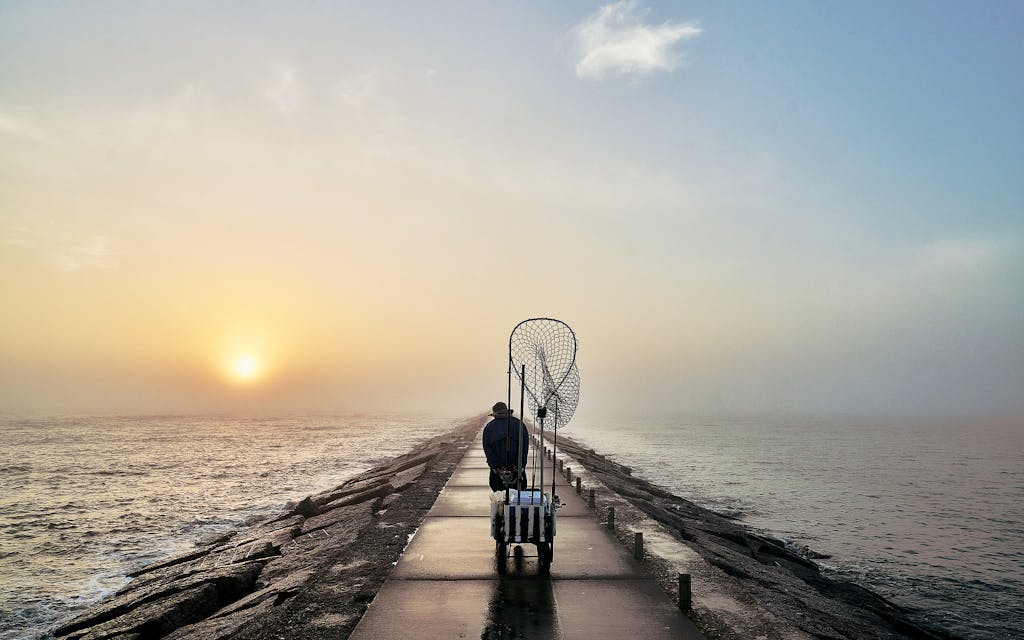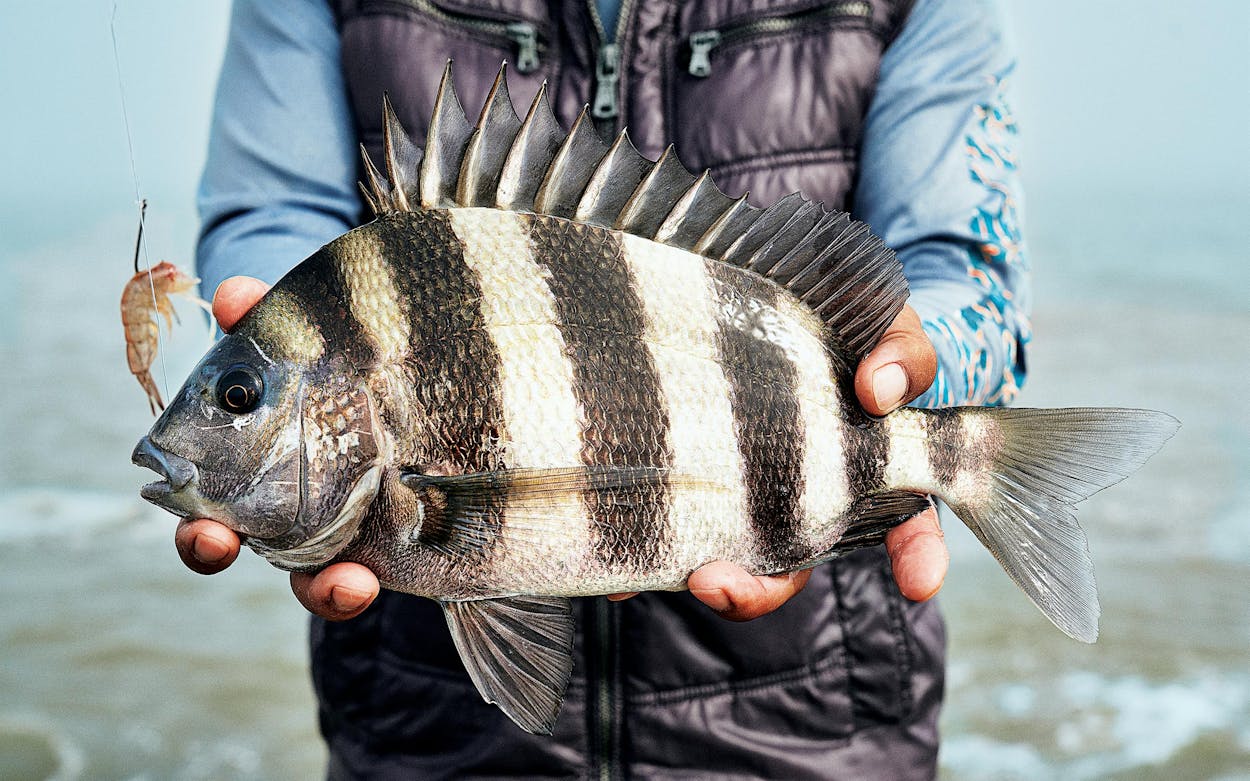The monikers and nicknames we’ve doled out to most fish species tend toward the obvious. You don’t have to be an avid angler or an ichthyologist (a scientist who studies fish)—heck, you don’t even need much of an imagination—to notice that speckled trout have speckles, for example. Gulf toadfish look like you-know-what. And guess what kind of sound Atlantic croakers make?
When it comes to the delicious Archosargus probatocephalus, a species found along the Atlantic and Gulf coasts, we have two naming options. Some call it the convict fish because the black-and-white vertical markings on its flat, oval body are reminiscent of the stripes worn by prisoners. The fish’s more common name is a little more creative: the sheepshead.
“It has these front teeth that stick out,” explained Shane Bonnot, a marine biologist who likes to take his kids fishing for sheepshead off Surfside Beach, about an hour south of Houston. “They’re very similar to the teeth of a sheep or goat.” Directly behind those incisors are rows of teeth that look more like molars and are useful for crushing shellfish. “I call them the swine of the sea because they eat just about anything,” he added. “They’re a neat little species.”


Although sheepshead also snack on algae, their appetite for crustaceans and mollusks is credited with giving their white, flaky flesh a rich and delicate taste. “The barnacles, crabs, and shrimp they eat impart an almost crustaceanlike flavor to the meat,” said Levi Goode, who grew up fishing along the Gulf Coast in Brazoria County on Chocolate Bay and Christmas Bay and is now the chef and owner of his family’s Houston-based restaurant empire, Goode Co. “It’s a real sweet meat, not dissimilar to crab or shrimp or even lobster, for that matter.”
With their less-than-appealing front teeth, plus a somewhat exaggerated reputation for being bony and difficult to clean, sheepshead have long trailed in the shadow of more popular sport fish such as speckled trout and redfish. In February 2021, sheepshead weathered the state’s catastrophic freeze much better than did specks, which were hit so hard that the Texas Parks and Wildlife Department has tightened limits on the recreational harvest of the species from the Rio Grande to East Matagorda Bay, south of Bay City, through the summer of 2023 to give them a chance to recover.
Which brings us back to the humble sheepshead. Bonnot, the advocacy director for the nonprofit Coastal Conservation Association of Texas, suggests that anglers consider giving specks even more room to rebound by targeting sheepshead, among other so-called alternative species. These fish might not be top of mind when you hit the salt, but they could be just as fun to catch and may turn out to be even tastier table fare.

On a Tuesday morning this past December, a group that included Bonnot, Goode, and me braved the soupy predawn fog to target sheepies, or sheepers, as some anglers call them, at the Surfside Jetty County Park in the sleepy town of Surfside Beach. The jetty, which protects a ship channel to the Freeport Harbor, is a breakwater of granite blocks extending more than half a mile into the Gulf of Mexico. The setting creates ample feeding areas for sheepshead, as the rocks attract crabs, shrimp, barnacles, oysters, and other shellfish. The sheepshead use their long pectoral fins almost like wings to glide and float in place, even as waves crash all around them—as Bonnot put it, “moving ever so gently around whatever it is they’re trying to eat.”
Armed with our fishing rods, we wandered up and down the jetty, casting toward the edges of darker, and therefore deeper, water, where sheepshead and other predators were more likely to lurk. We ran into a small problem, though. The sheepshead weren’t biting our live shrimp. They prefer to feed in clear water, rather than the turbid chop that this morning was serving up. I caught a couple of Gulf toadfish—they really do resemble those ugly, bumpy amphibians—and I reeled in an impressive red snapper, only for it to wiggle off the hook when it was nearly in the net.
As morning progressed, the fog eased and the sun rose like an apparition through the haze. Bonnot’s fishing buddy Richard Cabug, from nearby Lake Jackson, cast about ten feet from the jetty, not far from a dozen jellyfish-like Portuguese man-of-wars bobbing among dense mats of floating seaweed. Cabug waited, letting his shrimp drift about eight feet deep, mere inches above the submerged rocks. Then he felt that familiar tug.
“Fish on!” he shouted, a catchphrase Cabug pronounces with an exaggerated Texas twang, so that it sounds more like “fish own”—“like, ‘I own you, baby!’ ” he joked after he reeled in his catch—an average-sized female sheepshead of about twenty inches in length.
When they first take the bait, sheepshead have a gentle bite. Then the fun begins. “Once they realize they’re hooked, they fight and pull down. It’s a good, solid tug on your rod,” Bonnot said. “They’ve got a lot of muscle and shoulder on them, so they fight better than a trout of equal size.”
Other anglers had been trickling in throughout the morning. Nearly everyone on the jetty was, like Cabug, of Asian descent. Fishing near us were Nora Defontorum and her husband, Raul, a pipe fitter supervisor from Lake Jackson, who said the taste of sheepshead reminds him of a reef fish from his native Philippines. “My wife loves to grill sheepshead,” Raul said, noting that just one fish is enough for the couple’s dinner. They also like sheepshead fried with a sweet-and-sour sauce of garlic, sugar, and pineapple juice. “Sometimes you fish for food and sometimes just for fun,” said Raul, who takes his weekly jetty outings so seriously that he built a fishing cart equipped with three coolers and a patio umbrella. “Catching fish, you feel the excitement.”
The Defontorums also love to catch amberjack and the voracious Spanish mackerel, which have sharp fins that can slice through fishing line that isn’t strong enough. Other, perhaps less-heralded, sport fish recommended by Bonnot include the sand trout, which puts up a decent fight and has great flavor when fresh (but doesn’t freeze well), and the whiting, a sand-cruising bottom-feeder that’s fun for kids to catch on small hooks with little pieces of shrimp. “They don’t get very big,” Bonnot said, “but those are really tasty.”
Cabug’s sheepshead was the only one we landed that morning, but some members of our fishing party had caught a few the day before, so we caravanned from the jetty to Goode’s test kitchen in Stafford, in the Houston suburbs, to clean our catch and share in the rewards of the two-day haul.

Because of their armorlike scales and hard rib bones, sheepshead do seem as if they’d be a challenge to clean. There are tricks that make fileting a sheepshead a relative breeze, though, which primarily include inserting a knife into a soft spot behind the fish’s pectoral fin or slicing right against the backbone. It’s worth consulting a tutorial video or two on YouTube if you’re a newbie. Just take care not to touch the sharp dorsal fin spines, which aren’t poisonous but will smart if they stab you. “Working the meat off the bone takes a little practice,” Goode said, “but it’s absolutely worth the effort.”
In the kitchen, Goode’s crew whipped up an afternoon feast that started with both charred and raw oysters on the half shell, served alongside addictive chunks of sheepshead that had been dunked in a mixture of hot sauce, mustard, and beer and then rolled in seasoned cornmeal and slid into hot grease, a staple recipe dating back to cookouts in the Goode family’s old fish camp off Christmas Bay.
We also shared bite-size pieces that had been butter-poached, a classic technique for lobster tails, and we enjoyed grilled sheepshead with Gulf blue crab and Shiner Bock butter. For the grand finale, Goode scaled and scored a whole sheepshead. He stuffed its cavity with lemon pesto, garlic, butter, creole seasoning, and parsley, then roasted it on the half shell in a wood-fired oven for about half an hour. Finally, Goode drizzled the fish with chile-lime butter and served it up, its front teeth appearing even more pronounced after the softer mouth tissue had cooked off.
Goode was impressed; the fish had withstood his test-kitchen experiments. “I don’t know that we’ve come across anything that doesn’t work with sheepshead,” he said. “It’s flaky, but it’s not mushy. It holds up well to heat. If we could get a supply that we could share with our customers, I’d be interested.” At least for now, however, commercial fishers consider the market for sheepshead too limited and throw back the ones they catch. Sheepshead can also be broiled and baked; just be sure to remove the dark red bloodline when gutting the fish to improve the taste.
Bonnot, for his part, is convinced that sheepshead taste better than more-sought-after redfish or speckled trout and are on par with flounder, which is highly prized for its delicate, white flesh but—like the speck—has been in decline on the Gulf Coast in recent years.
He encourages fishers to bag a sheepshead or two, along with other thriving species such as sand trout and whiting, which he tries to do when he goes out with his wife, Lauren, and their three children, ages nine to fourteen. “You’re still fishing,” Bonnot said. “You’re still taking kids out there and engaging in the sport.” By going after different types of fish, he said, you’re not just helping the sea trout population recover from the 2021 freeze. You’re also broadening your skill set. “Some people are redfish guys, and that’s all they do. There are trout guys, and that’s all they do,” he added. “That’s all fine and good, but the general angler should be flexible and be able to target all kinds of different species.”
Best of all, perhaps, you don’t need an expensive boat—or any boat, for that matter. “My wife and our kids and I love to fish the surf, and we love to fish the jetties,” Bonnot said. “If we didn’t know how to approach each of those situations, our kids would not have had as many tugs on the line as they do.”
This article originally appeared in the May 2022 issue of Texas Monthly with the headline “Don’t Fear the Sheeper.” Subscribe today.
- More About:
- Hunting & Fishing
- Fishing









